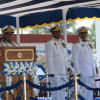A model for the rules-based system in Asia
Beginning 2016 with a trip to the region for the Indian Ocean Naval Symposium (IONS) hosted by the Bangladesh Navy in Dhaka sets the tone for the year ahead. At IONS, regional naval leaders met in person to deepen cooperation, highlighting where our interests intersect and offering us a chance to identify where they diverge. Having visited Bangladesh many times, this trip also underscored the growing importance of the US-Bangladesh navy relationship.
That relationship reflects our shared commitment to cooperation on behalf of freedom of the seas and the international rules-based system. The Bangladesh Navy now operates two former US Coast Guard Hamilton-class cutters, BNS Somudra Joy and BNS Somudra Avijan, in the Bay of Bengal and beyond. Our annual naval engagement, Cooperation Afloat Readiness and Training (CARAT) Bangladesh, wrapped up off the coast of Chittagong last October. During CARAT, our navies conducted exercises on counter-piracy, counter-smuggling, maritime interception operations, and port security. Also in 2015, the Bangladesh Navy became the first South Asian navy to observe the Southeast Asia Cooperation and Training (SEACAT) exercise in Singapore and we welcome their participation in future convenings.
Some assume from the name "U.S. Pacific Fleet" that we focus only on maritime interests east of the Straits of Malacca and Singapore. Nothing could be further from the truth. Looking east of the Straits, maritime disputes and the potential erosion threaten the international rules-based system that has benefitted so many nations. Looking west, however, I see promising trends of peaceful resolution of disputes and growing maritime cooperation between regional navies.
On both sides of the Straits, competition and cooperation are rooted in the growing interdependence between maritime trade and economic prosperity. Thirty percent of global maritime trade, roughly $5.3 trillion yearly, passes through the South China Sea alone. Nearly 100,000 ships transport these goods to and from Indian Ocean ports stretching across the Arabian Sea and the Bay of Bengal along trade routes established centuries ago when monsoon winds governed the age of sail. Beyond trade, access to oil and gas resources below the sea and fishing stocks on the surface are enduring sources of livelihoods.
A safe and secure maritime environment enables the free flow of international trade. In recent years, two longstanding bilateral disputes were resolved peacefully in accordance with international law. In 2012, the International Tribunal for the Law of the Seas decided a maritime border dispute between Bangladesh and Burma that benefitted both nations and marked the first time the Tribunal adjudicated such a case. A different organisation, the Permanent Court of Arbitration, resolved Bangladesh's western maritime border dispute with India two years later. All three nations demonstrated regional leadership by agreeing to these proceedings and by accepting the rulings. I'm hopeful that other Asian nations involved in protracted maritime disputes will consider these examples and pursue similar approaches in forums recognised by international law as viable options for peaceful resolution.
When nations employ naval forces to deter aggression and protect freedom of the seas, the entire region becomes more secure and prosperous. Multinational patrols to eradicate piracy off the coast of Somalia and in the Gulf of Aden are clear examples. More than a decade ago, relief efforts following the 2004 Indian Ocean Tsunami, and more recently, search efforts for the missing airliner MH-370 are positive examples of regional navies working together in response to tragic events beyond the resources of any single nation. Because all of the above challenges are enduring, it is so important that the US and Bangladesh navies continue practicing key naval competencies during exercises like CARAT and SEACAT.
I look forward to returning to the Indian Ocean region and to hosting many of its navies later this year during the Rim of the Pacific exercise in Hawaii. Based on what I've seen so far, I think the view will be stunning.
The writer is Commander of the US Pacific Fleet.

 For all latest news, follow The Daily Star's Google News channel.
For all latest news, follow The Daily Star's Google News channel. 








Comments